Board Game: Gambit
Gambit is a two or four player board game in which the object of to capture your opponent’s queen tile by moving three other tiles across the board. In the original two player variation, the players protect their queen with two guards and one warden.
In the four-player variation, teams of two work together to protect their queens from the advancement of the enemy team, and the game is over when both of a team's queens are captured. This version can last much longer if played right.
Traditionally after a four-player match is decided, a two-player match is played between teammates. Though there are variations on the rules of gambit, this article will outline the most common ones.
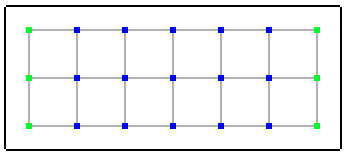
by Whiterose912
A two-player gambit board with home space pips indicated in green.
History
Gambit has been played for centuries, since before the garror were born but after the titans departed. There are three theories to what the game originally was used for. Some believe it was used to predict the appearance of the titans and how they step through the planes, others say it was used to plan advancements of troops through unknown territory, and the gnomes believe it was created by the dwarves as a tool of warfare.
The four-player gambit board variation was developed when the two-player game became too cumbersome with all the boards, and they were combined so two games could be played at once to save space and time, albeit with a modified rule set. Although four player games can be played with the warden tile, most four player games are played with three guard tiles.
Gnomes are especially fond of the game due to its connections with the dwarven myth, and the kjeri seldom play it, instead preferring their own cultural games.
Pieces
Gambit boards are commonly made in titanish language style, and sold with all the pieces needed to play a two-player match: two queens, two wardens, and six guards. To distinguish players from each other, the tiles are coloured black and white and are double sided. These sides are called faces.
On one side of a tile is a symbol, and on the other is a letter: crown and Q for queens, shield and W for wardens, and sword and G for guards. This allows a set of tiles from a two-player board to be played with a four-player board easily, without causing confusion, though different coloured tiles also work. A tile with the symbol face showing is symbol-up, and those with the letter face showing are letter-up.
Set-Up
The two-player game is played on a 7 by 3 grid with the intersections of the lines counting as the playing areas, known as spaces or pips. Each player starts by placing a warden tile on the middle pip in their home spaces, and guard tiles on either side. In four player gambit, three guard tiles are played instead, but a warden tile may be substituted for a guard tile.
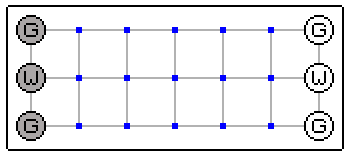
by Whiterose912
Basic set up of a two-player gambit board.
Movement & Victory Condition
Although there is a queen tile, under common two player rules it is not played on the board and does not move. The queen tile is mostly used to indicate that you want to jump in and play a round, you place the tile down on the middle pip of the home spaces in front of you for any challengers to see, if there is no queen tile on the board then it indicates you are no longer accepting matches.
The queen tile can also be placed beside the gambit board to show onlookers which player is white and which is black, and in the case of four-player matches, which players are letters-up or symbols-up.
The warden moves one space at a time horizontally or vertically, and guards have the additional ability to move diagonally. While tiles can move to any unoccupied square, and are capable of moving backwards, they cannot move back to the home spaces. There is no capturing in gambit, only movements, and each player must move one tile when it is their turn.
The game is won when one player gets all of their tiles to their opponent’s home spaces. In the case of four-player matches where no warden tiles are used, the guards must reach the corner tiles of their opponent’s home spaces.
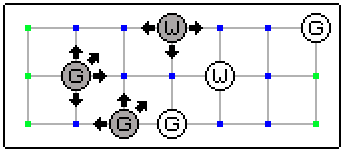
by Whiterose912
Possible moves that can be made by the black tiles on the board.
Variations
There are two common and recognised variations of gambit: queen's gambit, and mage's gambit.
Queen's gambit is played the same as classic gambit, but the queen tile is placed on the board, either replacing the warden or becoming another, being able to move one space horizontally or vertically. The goal is still to get three pieces to the home spaces of the enemy, however you must also protect your queen from the enemy warden or queen, as if they are captured the game ends.
Mage's gambit removes the warden from play and introduces a six-sided die to classic gambit, this die represents the mage. Before a player can move a piece, they must roll the die. If they land on a one, they cannot move any tile at all, but if they land on a six, they may move both tiles. Any other number allows them to move normally. Unlike classic gambit, the goal is to get each of your tiles to the opponent's home spaces and return to your own home spaces. This variation is most often used for gambling.
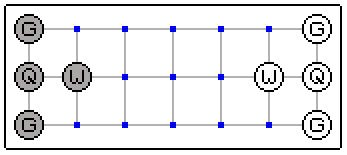
by Whiterose912
Set-up of a game of queen's gambit with the queen and warden both in play.
Additional Images
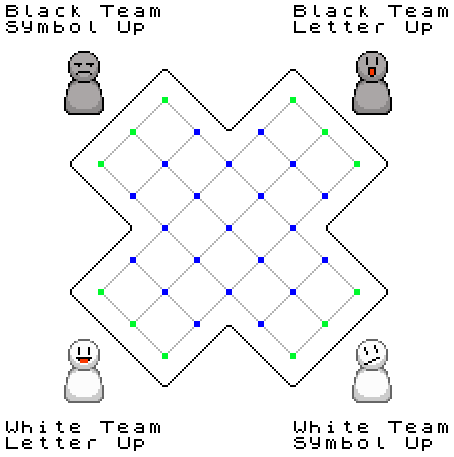
by Whiterose912
Basic set up of a four-player gambit board.
Remove these ads. Join the Worldbuilders Guild









Comments